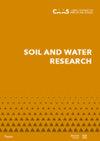不同土壤类型土壤微生物对土地利用的响应
IF 1.7
4区 农林科学
Q4 SOIL SCIENCE
引用次数: 9
摘要
本研究的目的是了解土地利用如何影响不同土壤类型的土壤微生物属性以及影响深度。这项研究是在斯洛伐克(欧洲)的三个不同土壤类型的地区(黑钙土、Stagnosol和Cambisol)进行的。在每个区域内,选择了三个具有不同土地利用的地方(森林、草原、农田),代表了具有不同管理强度的梯度。土壤样本沿单个土壤剖面采集,深度为1m,每个位置增量为10cm。在土壤样品中,测定了土壤的基本化学性质和微生物属性。土地利用对微生物生物量和基础呼吸的影响主要在顶部30cm的黑钙土中观察到,而在Stagnosol中,不同生态系统之间的微生物生物量沿土壤剖面的趋势没有差异。N矿化反映了不同的管理实践,尤其是在顶部20 cm的土壤中。在整个剖面上,不同土地利用的土壤之间的过氧化氢酶活性差异最大。不同土地利用的土壤中功能组的丰富度和多样性没有显著差异,也没有观察到功能组组成对土地利用的统一反应。微生物的生物量和活性主要受土壤有机质含量的影响;冲击强度因土壤类型而异。本文章由计算机程序翻译,如有差异,请以英文原文为准。
Responses of soil microorganisms to land use in different soil types along the soil profiles
The objective of this study was to find out how land use affects the soil microbial attributes in different soil types and to which depth. The study was performed in Slovakia (Europe) in three areas differing in soil type (Chernozem, Stagnosol, Cambisol). Within each area, three localities with different land use (forest, grassland, cropland), representing a gradient with different intensity of management, were chosen. The soil samples were taken along a single soil profile up to a depth of 1 m with 10 cm increments at each locality. In the soil samples, the basic soil chemical properties and microbial attributes were determined. The effect of the land use on the microbial biomass and basal respiration was mainly observed in the Chernozem in the top 30 cm, while in the Stagnosol, no difference in the trend in the microbial biomass between the different ecosystems along the soil profile was found. The N-mineralisation reflected the different management practices especially in the Cambisol in the top 20 cm. The most distinct differences in the catalase activity between the soils differing in land use were found in the Cambisol along the whole profile. The richness and diversity of the functional groups did not differ significantly between the soils with the different land use and also no uniform responses of the functional groups composition to the land use were observed. The microbial biomass and activity were mainly affected by the amount of the soil organic matter; the intensity of the impact differed according to the soil type.
求助全文
通过发布文献求助,成功后即可免费获取论文全文。
去求助
来源期刊

Soil and Water Research
Water resources, Soil Science, Agriculture-WATER RESOURCES
CiteScore
4.60
自引率
0.00%
发文量
26
审稿时长
>12 weeks
期刊介绍:
An international peer-reviewed journal published under the auspices of the Czech Academy of Agricultural Sciences and financed by the Ministry of Agriculture of the Czech Republic. Published since 2006.
Thematic: original papers, short communications and critical reviews from all fields of science and engineering related to soil and water and their interactions in natural and man-modified landscapes, with a particular focus on agricultural land use. The fields encompassed include, but are not limited to, the basic and applied soil science, soil hydrology, irrigation and drainage of lands, hydrology, management and revitalisation of small water streams and small water reservoirs, including fishponds, soil erosion research and control, drought and flood control, wetland restoration and protection, surface and ground water protection in therms of their quantity and quality.
 求助内容:
求助内容: 应助结果提醒方式:
应助结果提醒方式:


